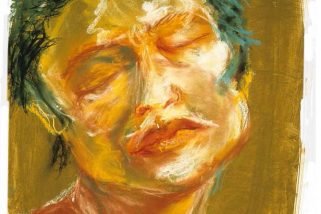
“A Village of Their Own” by Niloufar Behrooz
There is a small village in Iran called Abyaneh. You might notice this ancient red village on your way to Tehran from Isfahan. Abyaneh is one of the oldest villages in Iran, known to have existed around 2,500 years ago, and it is considered a major tourist attraction for its historical, anthropological and architectural antiquity as well as its rustic atmosphere. The village is almost secluded of residents since the majority of the second generation have migrated to nearby cities over time. The only people who actually do live in the village are the old local men and women who wander around the narrow alleys going about their daily errands hiding their faces from the camera-crazed tourists.
But it isn’t the men who are the center of attention in this village. It’s the women. The wrinkled tiny little women who sit on their high wooden balconies, wearing their traditional colorful clothes with exquisite flower patterns on them, like decorative dolls sitting on a shop window. Pristine, authentic and aesthetic. They are showcased in their absolute originality and eccentric beauty; only to be looked at, but never to be touched, bought or translated. They are the shining jewels of the village. Some of them are as old as a hundred, and most of them are seen to be living alone. Either single or widowed, these women don’t seem to need the helping hand of a man, at least not anymore. Behind their porcelain fragile figures, they have the strength, endurance, and perseverance of an inveterate desert plant. Of course, there are some who lean their chins on their small hands and gaze into the distant setting sun with doleful eyes that glisten with the memories of their progenies, but even those will put a smile on their face when they see a visitor pass by. Sometimes they’ll even wave at you. You wave back and then for a moment you feel connected to their noble existence and sublime mystery.
Time has stopped in this village. Almost no signs of highly advanced technologies or vehicles can be seen. Transportation is simple. You walk. You feel the permanence of everything around you. But if you ask the colorfully-clad women in the village they will tell you that they have not stayed here out of weakness or helplessness but out of their own choice and consent. Surely, they could have gone on to live with their children and grandchildren in big cities. But why leave when they have a village of their own?
____________________
Share your response to this work, in any form, here

Niloufar Behrooz Artist Statement:
Niloufar Behrooz is a PhD candidate of English Literature in the University of Isfahan, Iran. She
is a poet, essayist, musician, translator and language instructor. Her work has appeared in The
Literary Hatchet, Litro Magazine, Haiku Presence, Gema Online Journal and elsewhere. Music,
languages, performative arts and gender studies are among her interests. You can find her on her
Instagram page: https://www.instagram.com/niloufar.behrooz/
(Isfahan, Iran)






